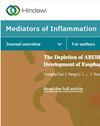Atherosclerosis and Toll-Like Receptor4 (TLR4), Lectin-Like Oxidized Low-Density Lipoprotein-1 (LOX-1), and Proprotein Convertase Subtilisin/Kexin Type9 (PCSK9)
IF 4.4
3区 医学
Q2 CELL BIOLOGY
引用次数: 0
Abstract
Atherosclerosis is a leading cause of death in the world. A significant body of evidence suggests that inflammation and various players are implicated and have pivotal roles in the formation of atherosclerotic plaques. Toll-like receptor 4 (TLR4) is linked with different stages of atherosclerosis. This receptor is highly expressed in the endothelial cells (ECs) and atherosclerotic plaques. TLR4 activation can lead to the production of inflammatory cytokines and related responses. Lectin-like oxidized low-density lipoprotein-1 (LOX-1), an integral membrane glycoprotein with widespread expression on the ECs, is involved in atherosclerosis and has some common pathways with TLR4 in atherosclerotic lesions. In addition, proprotein convertase subtilisin/kexin type9 (PCSK9), which is a regulatory enzyme with different roles in cholesterol uptake, is implicated in atherosclerosis. At present, TLR4, PCSK9, and LOX-1 are increasingly acknowledged as key players in the pathogenesis of atherosclerotic cardiovascular diseases. Herein, we presented the current evidence on the structure, functions, and roles of TLR4, PCSK9, and LOX-1 in atherosclerosis.动脉粥样硬化与 Toll-Like Receptor4 (TLR4)、Lectin-Like Oxidized Low-Density Lipoprotein-1 (LOX-1) 和 Proprotein Convertase Subtilisin/Kexin Type9 (PCSK9)
动脉粥样硬化是导致全球死亡的主要原因之一。大量证据表明,炎症和各种因素都与动脉粥样硬化斑块的形成有关,并在其中发挥着关键作用。Toll 样受体 4(TLR4)与动脉粥样硬化的不同阶段有关。这种受体在内皮细胞和动脉粥样硬化斑块中高度表达。TLR4 激活可导致产生炎症细胞因子和相关反应。凝集素样氧化低密度脂蛋白-1(LOX-1)是一种在血管内皮细胞上广泛表达的完整膜糖蛋白,参与动脉粥样硬化,在动脉粥样硬化病变中与 TLR4 有一些共同的途径。此外,PCSK9 也与动脉粥样硬化有关,PCSK9 是一种调节酶,在胆固醇吸收过程中发挥着不同的作用。目前,TLR4、PCSK9 和 LOX-1 越来越被认为是动脉粥样硬化性心血管疾病发病机制中的关键角色。在此,我们介绍了目前有关 TLR4、PCSK9 和 LOX-1 的结构、功能和在动脉粥样硬化中的作用的证据。
本文章由计算机程序翻译,如有差异,请以英文原文为准。
求助全文
约1分钟内获得全文
求助全文
来源期刊

Mediators of Inflammation
医学-免疫学
CiteScore
8.70
自引率
0.00%
发文量
202
审稿时长
4 months
期刊介绍:
Mediators of Inflammation is a peer-reviewed, Open Access journal that publishes original research and review articles on all types of inflammatory mediators, including cytokines, histamine, bradykinin, prostaglandins, leukotrienes, PAF, biological response modifiers and the family of cell adhesion-promoting molecules.
 求助内容:
求助内容: 应助结果提醒方式:
应助结果提醒方式:


